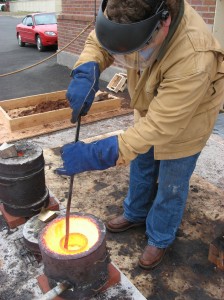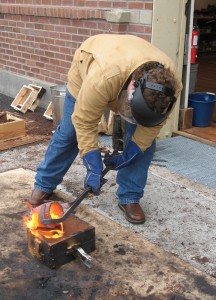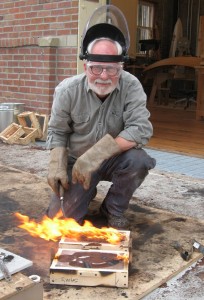A short stroll along Astoria’s Riverwalk from the downtown will take you past the city’s traditional canneries and docks to the Columbia River Maritime Museum (CRMM)–one of the West Coast’s finest centers for marine history. Inside, you can step back to the time when boats were built by hand in small workshops along the lower Columbia River, and skills like steam-bending timbers and riveting planks were practiced by generations of craftsmen. 
This summer, the museum has seen a remarkable revival of these traditional nautical crafts, in classes taught in the city’s historic railroad depot, recently re-opened as the new Barbey Maritime Center. However, the classes go far beyond nautical woodwork, and even include the “lost” art of bronze casting to create the many deck fittings needed to complete any type of boat. This class is taught inside the depot’s freight room, now converted into a large workshop, but for health and safety reasons, the actual furnace operation and casting took place outside the building, beside the railway tracks.
Here passers-by could watch as a small propane furnace heated the bronze to 1800 degrees F., when one of the students (after only a day’s instruction) made their first attempt at pouring the liquid metal. He removed the clay-graphite crucible from the heat source with tongs and carefully but quickly aimed a steady stream of red-hot bronze into the sand mold he had prepared. Flames shot up as the wooden mold box ignited briefly, followed by smoke and steam as the water in the sand evaporated. After a brief wait, the the casting was extracted from the mold, dipped into a quenching bucket, and ready for inspection, cleaning, sanding and polishing.
 This ancient craft is still practiced by a few small foundries in the USA that specialize in nautical work, manufacturing fittings for traditional craft rigs or custom pieces for modern designs. But is really not as complex as one might imagine—at least for basic shapes like cleats and fairleads. Sam Johnson, the museum’s executive director, has been teaching the subject for many years, and finds there is growing interest from amateur boat builders who want the satisfaction of casting the fittings for their own craft.
This ancient craft is still practiced by a few small foundries in the USA that specialize in nautical work, manufacturing fittings for traditional craft rigs or custom pieces for modern designs. But is really not as complex as one might imagine—at least for basic shapes like cleats and fairleads. Sam Johnson, the museum’s executive director, has been teaching the subject for many years, and finds there is growing interest from amateur boat builders who want the satisfaction of casting the fittings for their own craft.
This is just one of many forgotten skills that have been taught at the Astoria station, itself a fine piece of history dating from 1925 for the Spokane, Portland and Seattle Railroad. Other subjects included traditional rope and canvas work and Native American wood carving. “You will go away from all these courses with the knowledge and confidence that you can create beautiful and useful objects out of traditional materials,” says Johnson. “We know that your curiosity will be whetted, and most of all, that you will have an entertaining and enriching experience.”
He also hopes to organize longer five-day sessions where students will build their own kayak, canoe or dinghy. Go to www.CRMM.org for more information about the museum and the classes, or call 503-325-2323 for Carol Shepherd.



